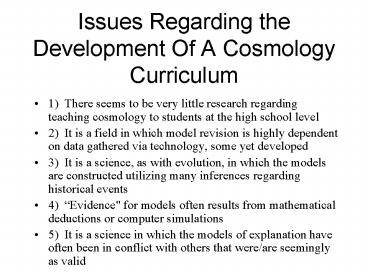Issues Regarding the Development Of A Cosmology Curriculum - PowerPoint PPT Presentation
1 / 15
Title:
Issues Regarding the Development Of A Cosmology Curriculum
Description:
Issues Regarding the Development Of A Cosmology Curriculum. 1) There seems to be very little research ... Geocentric view of Aristotle, Ptolemy, medieval Europe ... – PowerPoint PPT presentation
Number of Views:53
Avg rating:3.0/5.0
Title: Issues Regarding the Development Of A Cosmology Curriculum
1
Issues Regarding the Development Of A Cosmology
Curriculum
- 1) There seems to be very little research
regarding teaching cosmology to students at the
high school level - 2) It is a field in which model revision is
highly dependent on data gathered via technology,
some yet developed - 3) It is a science, as with evolution, in which
the models are constructed utilizing many
inferences regarding historical events - 4) Evidence" for models often results from
mathematical deductions or computer simulations - 5) It is a science in which the models of
explanation have often been in conflict with
others that were/are seemingly as valid
2
Overarching Questions Of Cosmology
3
Other Questions ToBe Addressed
4
An Exploration Of Two ModelsOf The Universe (An
Attempt To Highlight/Address The Previous
Questions)
- Steady State Model
- Popular until the 1950s
- Main problems
- Necessitates creating new material from nothing
- Requires special process to create microwave
background radiation - Predicts that overall appearance of universe
should not change over time
- Big Bang Model
- Growing evidence for
- 1964 serendipitous discovery by Penzias and
Wilson regarding background, uniform cosmic
radiation seems best proof - Based on Doppler Effect and photons being
stretched to microwave radiation
5
Both Models Allow For Expansion Of Universe
- In addition, a study of the development of this
idea sets the stage for the rest of unit,
historically and in terms of student familiarity
with skills and knowledge - Evidence is galaxies movement away from one
another - Is historical controversy over existence of
galaxies, so ripe for historical reconstruction
of a model - Evidence for the movement of galaxies offered in
the early 1900s, though implications not
recognized by scientific community until decades
later - Galaxy movement/expansion of the universe
measurable in various ways, so much data is
available for student analysis
6
Misconceptions Based On Students Pretests
7
Historical Introduction (Regarding Galaxies)
- Reading that addresses key stages regarding the
existence of other galaxies - Geocentric view of Aristotle, Ptolemy, medieval
Europe - Heliocentric model of Copernicus and Galileo
- Kant and island universes, Charles Messiers
accidental discovery of galaxies in the 18th
century - Photography and the development of astrophysics,
William Herschels mapping of galaxies in the
19th century - (Facets of understanding to assess in
future-empathy and perspective)
8
Model Development By Student Of Movement Of
Galaxies
- Students perform spectral analysis of galaxies
- Using data of Vesto Slipher (1911- who noticed
light emitted from galaxies shifted red) and
current data of spectral emissions of stars
versus known spectral emissions of elements in
lab - Students will analyze for patterns and offer
explanations for phenomena - Discussion about already-familiar Doppler Effect
and implication of data, especially in terms of
redshift/velocity correlation (greater
redshifthigher velocity)
9
Continued Building Of Expansion Of Universe Model
- Students measure distance to galaxies based on
measurements of cepheids as standard candles of
brightness - Then students perform analysis of Hubbles data,
identify patterns, offer explanations - Hopefully, students recognize relationship of
distance of galaxy vs. redshift/velocity (the
more distant the galaxy, the greater its
redshift, the higher the velocity)expansion of
the universe
10
Calculating Age Of Universe From Expanding
Universe Inferences
- Inference of Lemaitre (1927) that since galaxies
are moving apart, must have been closer in the
past in more compressed state - Assuming speed has been constant, and knowing
distances of galaxies, can calculate when motion
began, thus age of universe - Calculation by students (tD/V)
- Hubble law relates velocity to distance (VDH)
- So, tD/DH
- t1/H
- t15 billion years
11
Developing The Big Bang Model
- Hubble Constant is Holy Grail for
cosmologistspossible to estimate age if
universethere must BE age of universe - In addition, discovery of background radiation
adds evidence in support of model (this can be
presented to students as story of serendipitous
discovery) - The Steady State model, having no way to account
for this radiation, does not prove as valid
12
Most Current Theories In Cosmology Are Variants
Of The Big Bang Model
- Understanding of universe reliant upon
observatonal data made possible by technology
such as HST, but how do cosmologists test their
various models?
13
Theory Combined With Data Allows For Computer
SimulationOf Things Not Directly Observable
- NSF project, the Grand Challenge Cosmology
Consortium, tests models of the cosmos - Utilizes high perfromance computing and
communications - Is joint venture of cosmologists, astrophysicists
and computer scientists in the US, coordinated by
U of Illinois - Provides AMAZING website that students can visit
to learn about the project/technology, witness
computer simulations of models of the Big Bang,
watch movies of cosmologists at work and
discussing their projects, and pose questions to
current scientists in the field.
14
The Results Of Such An Approach
- Can then be compared to observations available in
the future as technology is developed to better
make such observations
15
A Possible Activity To Develop
- Comparing current data from HST or other source
with simulation from GCCC - (Testing of facets explanation, interpretation,
application)































